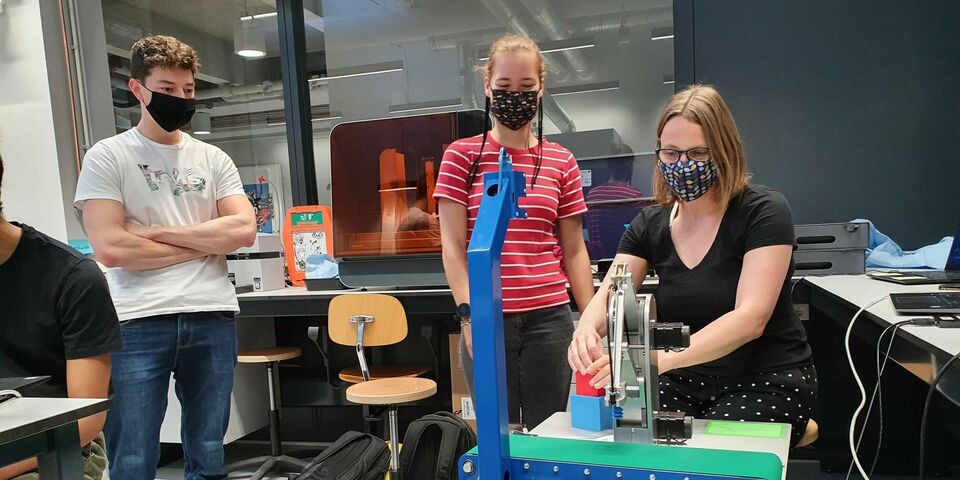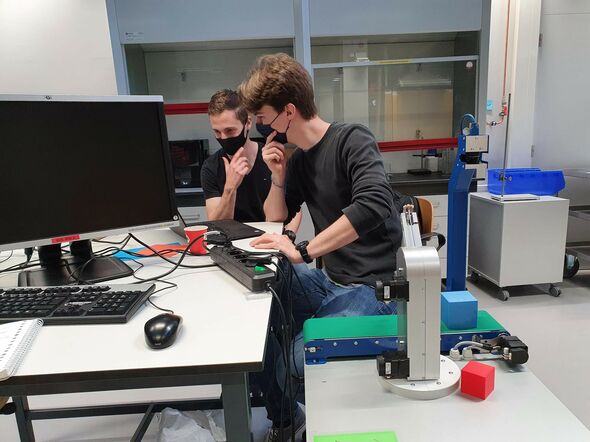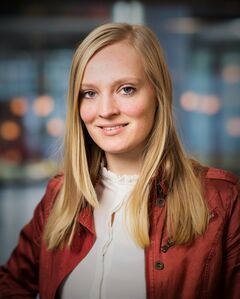How do you make courses CBL-proof?
Second-year students at the departments of Mechanical Engineering and Applied Physics had the opportunity this academic year to follow a new version of the traditional courses Signals and systems (AP) and Robot Arm (ME). A Challenge-based learning (CBL) version during which students have to work on an open-ended assignment in interdisciplinary teams. This pilot could contribute to a CBL-climate at TU/e.
The high-tech robot arm with which 23 ME and 7 AP students got to work with during this academic year’s final quartile had been around for some time already. Master’s student Tim van Esch first worked with it during the course Robot Arm. This compulsory course is taught during the second year at ME and a comparable course with a different set up is taught during the second year at AP. These courses have now been merged into the course Systems and control.
Van Esch is one of three tutors, as a master’s student, of the alternative Systems and control project. He and a few others modified the robot arm by adding a treadmill, a vacuum pump and a camera, and collected the corresponding software. The learning objective is to design and implement a controller. Students are relatively free when it comes to how they achieve this knowledge and these skills. Preferably with real-world assignments they came up with themselves.
Choose your shareholder
AP student Marieke Mulders is part of a group that would like to come up with a solution for blood bank Sanquin. That is why the group wants the robot arm to sort out bags with donated blood by blood type. She contacted the organization and was told that this wasn’t some wild idea. “A company is currently actually working on an automated blood processing system. A device that controls and centrifuges blood, among other things. I was also told that the most important requirement is that the system needs to be one hundred percent error proof. We will incorporate that requirement in our design.”
Social involvement also plays a role in ME student Owen Lentjes’ group. This group wants to have the robot arm sort our plastic waste. A red, yellow and a blue block pass by on a conveyor belt. This morning, they tested whether the vacuum pump is properly adjusted so that the blocks can be picked up. “It works quite well already. During our next timeslot with this setup in innoSpace, we will go through the entire script once more.”
Educational innovation
In TU/e’s Strategy 2030, CBL is one of the pillars of future education in Eindhoven. The development of CBL at TU/e will be evaluated in 2025. Experiments are carried out in several fields; Cursor wrote about it earlier.
Anne Limburg, who was appointed as a PhD candidate for a five-year period at AP and who spends one fourth of that appointment on education, is involved in the development of this specific Systems and control project in her capacity as teacher. “The initiative came from program director Henk Swagten (AP) and Camilo Rindt, who was program director at ME at the time. When the idea came about to let students collaborate and learn from each other, I was allowed to develop the plan together with a few others. There are quite a few practical matters involved. Where does it fit in with the bachelor’s timeline? Who will take part in the pilot? How do we imbed it in the Education and Examination Rules (OER)? For example, the OER requires that you indicate the assessment parts and the numbers of participants one year in advance. We already need to indicate adjustments for Q4 in the academic year 21/22. And we are working on a pilot, which we are running to find out what works and what doesn’t work.”
Areas of improvement
There are a few things that could be changed, as far as ME student Lentjes is concerned. “I would like to offer two recommendations that deal with the preparations and with Canvas. Make sure that all files are ready for us in time. This time, the code for the camera wasn’t ready yet, for example. I understand that this is a pilot, but start with the preparations sooner. And Canvas only shows separate files. I would like to see that neatly arranged in a scrollable PDF. Now I have to click like crazy.” The teacher team confirms that much work was done during the quartile to make all information available to the students, and says that plans have been made to further improve this next year.
Motivation
Marieke Mulders is very satisfied with the fact that the project involved a selection procedure. “Since we had to write a motivation letter, I knew in advance that fellow group members would collaborate enthusiastically. I think that this is exactly the reason why I wanted to take part.” Her wish came true, and despite the fact that the project takes more hours than expected, she’s still glad to be part of it. “I’ve learned a great deal from the mechanical engineers. They have a more practical approach than physics students like myself. It was fun to collaborate.”
Lentjes’ motivation was to gain more practical experience. He is a bit disappointed that there wasn’t more contact with Vanderlande. “We were presented with a lecture at the start and we will go on a tour of the company, but there won’t be any other contact moments. That’s a pity.”
Pilot
There were still a significant number of corona restrictions in place during the quartile’s first weeks. “That’s why the lecture at the start couldn’t take place physically, and why it wasn’t possible to plan the tour at the start of the course,” Limburg acknowledges. “For next year, we plan to organize more, and more intensified contact moments between students and stakeholders at the start of the course. Vanderlande will also be present during this edition’s poster presentation to provide the students with input.”
The teacher is satisfied with all the experiences gained during a difficult period marked by corona. “We managed to set up a new major course for two departments. The students are well on track to presenting a functioning robot for their self-elected problem. We can now use these experiences to set up other CBL courses and to further improve this one. Don’t forget that this is still a pilot phase.”




Discussion